Apple iPad mini with Retina Display: Reviewed
by Anand Lal Shimpi on November 16, 2013 8:00 AM ESTThe SoC
The iPad mini with Retina Display rounds out the three platforms that use Apple’s A7 SoC. Although both the iPad Air and iPhone 5S use the A7, the mini’s implementation is closer in nature to the iPhone. The iPad mini’s SoC has always used the same package-on-package (PoP) assembly as the iPhone, with DRAM stacked on top of the SoC itself (1GB in this case). The benefit is obviously a reduction in board area, the downsides have to do with cost and thermals. That’s the first similarity between the mini’s A7 and the iPhone’s A7.
The second is one of frequencies. While the iPad Air’s A7 runs its two Cyclone CPU cores at up to 1.4GHz, the SoC in the iPad mini and the iPhone 5S runs at up to 1.3GHz. That might sound like a minor difference, but it’s far more pronounced when you look at what happens to frequency when you’re running heavy workloads.
Once again I turn to a fairly heavy CPU workload to plot performance over time. This is a multithreaded workload, slightly modified from what we used in the iPad Air review, designed to make the CPU cores consume max power. The scale is linear and the workload is the same across all devices, so what you’re effectively looking at is a graph of thermally bound CPU performance over time across all three A7 implementations:
Being the largest device (and the only device with a metal heat spreader and no DRAM stacked on top), the iPad Air obviously maintains the highest frequencies for the duration of the test. The iPhone 5S, with a significant reduction in internal volume (and a PoP SoC) reduces its CPU frequencies early on in order to keep skin temperature down and properly manage thermals. The iPad mini with Retina Display falls between the two, with its performance curve more closely following that of the iPhone 5S.
Although the mini has a similar max operating frequency to the iPhone 5S, it is a faster device thanks to it being less thermally constrained. Similarly, the iPad Air can be much faster than its clock speed would otherwise imply. If you’re wondering why Apple has been so focused on building its own SoCs and CPU architectures, this is the reason why. There’s a fixed amount of power you can dissipate in the form of heat in these mobile devices while still maintaining a good user experience. Performance per watt is the gating metric for success in mobile, and shipping high IPC/low frequency dual-core SoCs at 32/28nm is the best optimization available to a company like Apple today.
As you’d expect, our browser based CPU tests show the mini’s A7 performing in between the iPhone 5S and iPad Air. None of these tests are anywhere near as stressful as our thermal test from above, so we don’t see exaggerated differences in performance between the platforms. For most, I suspect you won’t notice a huge performance difference between the mini and Air. Those who are heavier users (e.g. audio mixing, 3D gaming, etc…), there will be a performance difference between the two iPads.
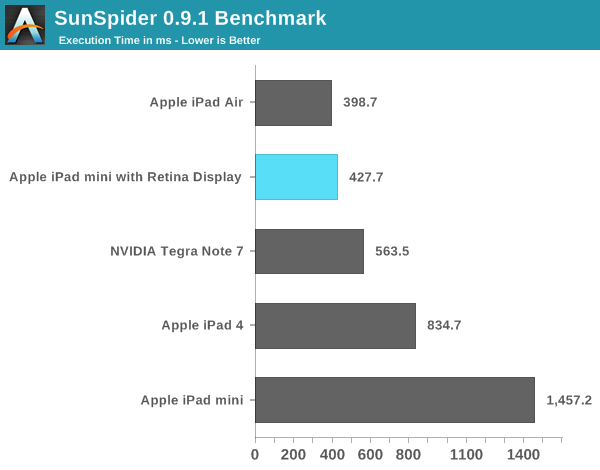

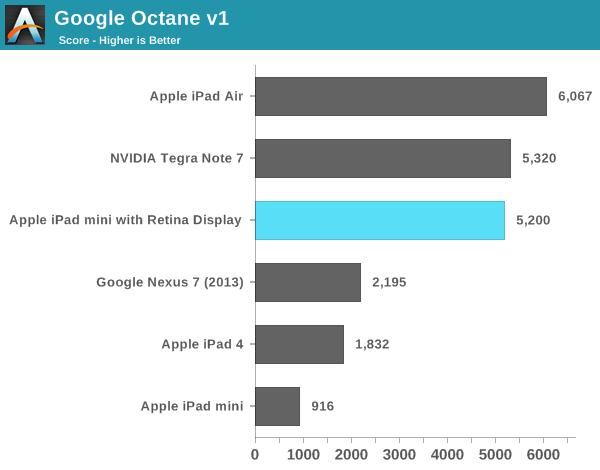
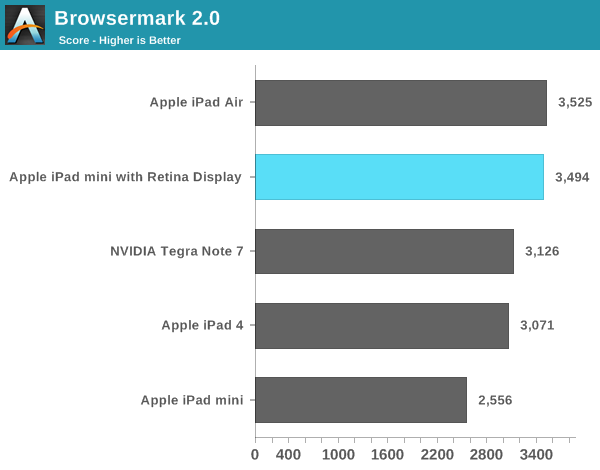
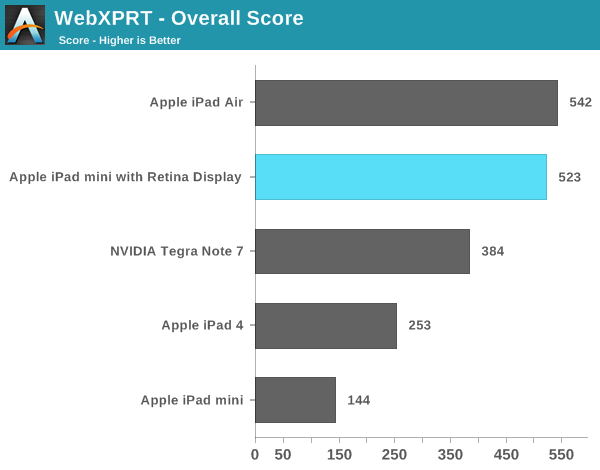
Compared to the first generation iPad mini, the new model is in a completely different performance league. Keep in mind the first mini used Apple’s A5 SoC based on an ARM Cortex A9. That’s the same single threaded performance as what’s in an iPhone 4S, and under iOS 7 it’s clearly running into some performance limits. The new mini with Retina Display however is a completely different animal. It’s fast.
Even comparing to the 4th generation iPad, the new mini is noticeably quicker.
Memory Bandwidth
Looking at the iPad mini’s memory bandwidth curve, we see it tracks very closely with that of the iPhone 5S. This is a slightly modified version of our previous bandwidth test, and you can see peak usable memory bandwidth (from the CPU’s perspective) of around 10GB/s. The ~12GB/s area right before you get out to main memory is bandwidth to the A7’s 4MB system-wide cache that sits after the shared L2 and the memory controller. This cache appears to service CPU, GPU and ISP requests at least.
GPU Performance
I believe the A7’s PowerVR G6430 GPU runs at around 450MHz. This frequency appears unchanged across all three A7 implementations. Once again, the big difference is how much thermal headroom exists in the platform which has an impact on overall performance.
Kishonti’s low level GPU performance tests back up my assertion that GPU frequency is fixed across all A7s. The iPad mini with Retina Display delivers equal performance to the iPad Air. The bigger news here is that nearly all of the GPU bound 3D tests seems to peg the mini and Air as equals. These are some pretty intense tests, but it looks like on the GPU side there’s no significant throttling when running at full tilt.
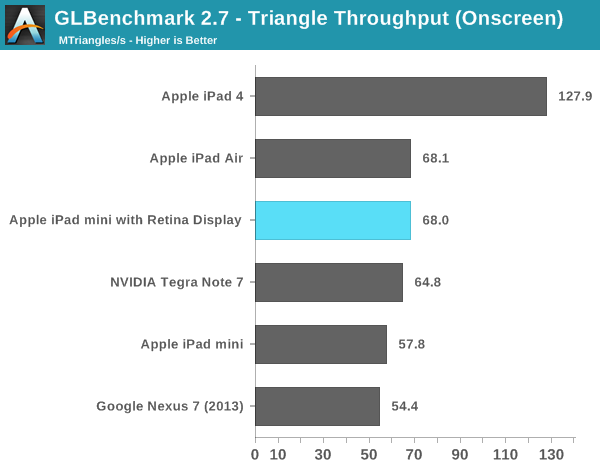

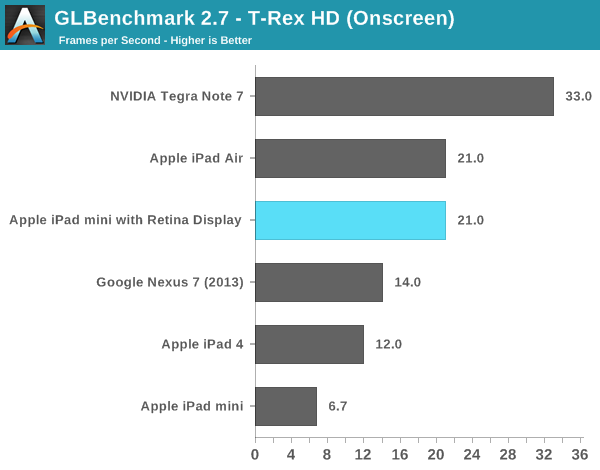

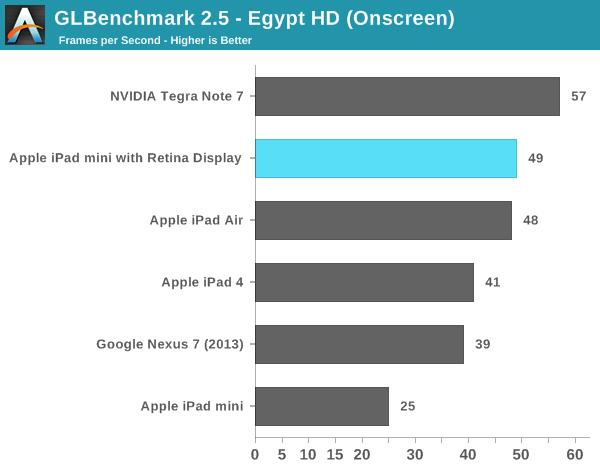
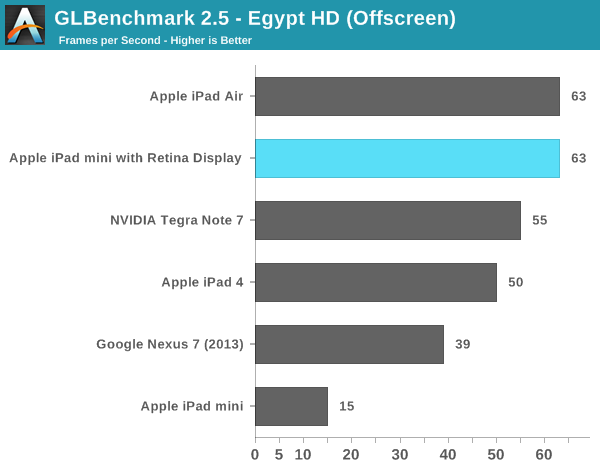
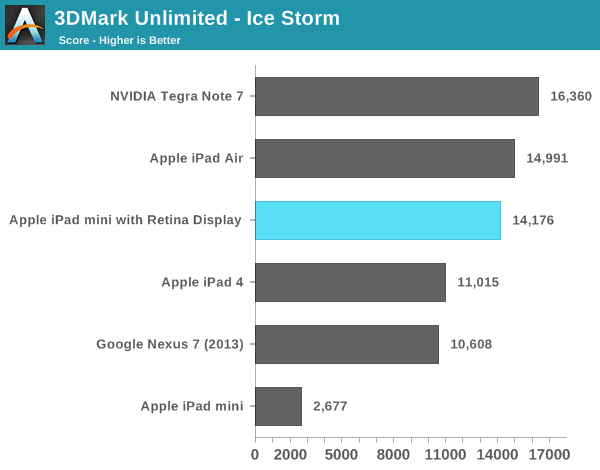
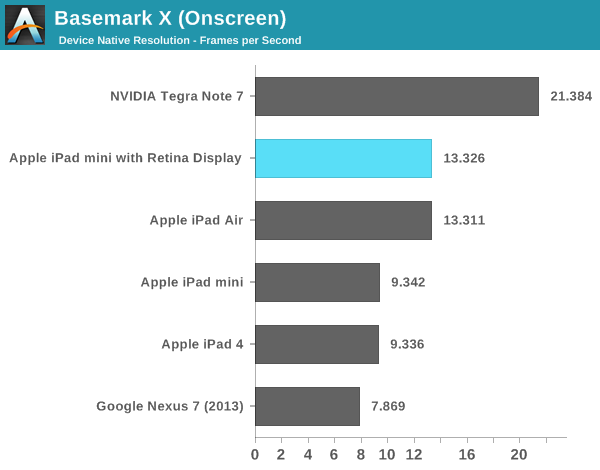
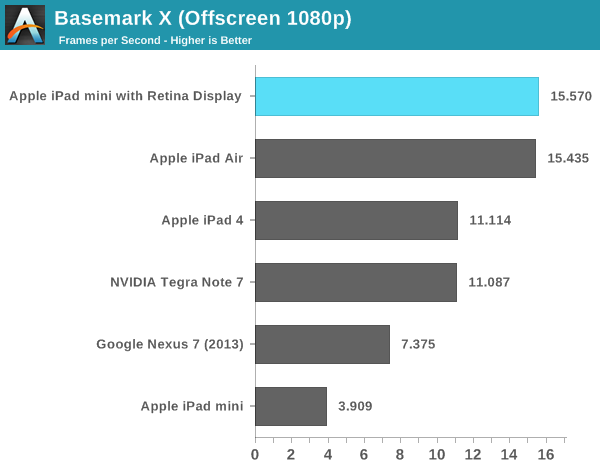
As I mentioned in our iPad Air review, despite having less peak theoretical memory bandwidth than the A5X/A6X, the A7 in the iPad mini never seems to regress in performance compared to even the iPad 4. Across the board the mini appears to be faster, more responsive and have more performance on tap than any prior iPad (big or small). The comparison to the original iPad mini is of course night and day. Even looking at lighter tests like the old GLBench Egypt HD benchmark, the iPad mini with Retina Display manages to be nearly twice as fast as the original mini - all while rendering 4x the number of pixels.


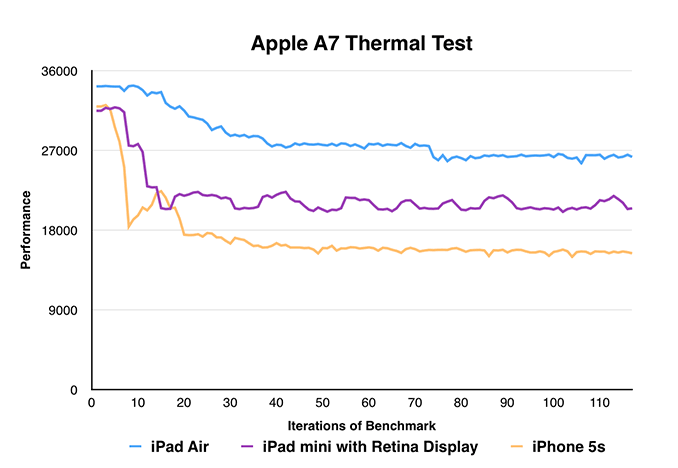
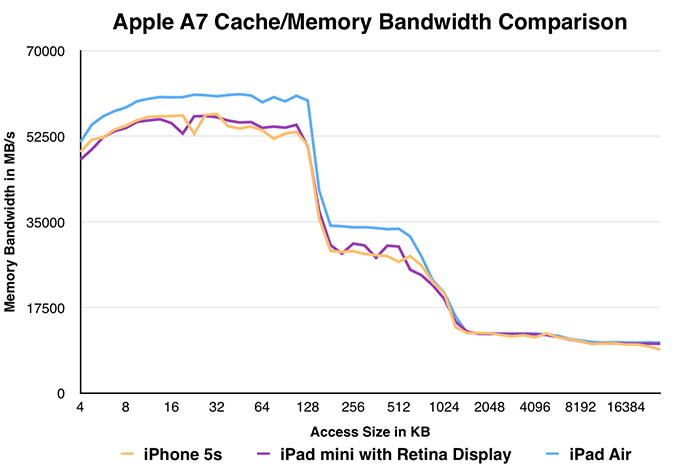








345 Comments
View All Comments
psyside1 - Sunday, November 17, 2013 - link
@Renasena ,No TouchID no thanks I'll wait till next year.
ROFL!!!!!
kwrzesien - Monday, November 18, 2013 - link
Do you want retina mini's or not? TouchID is constraining the 5s production, and retina displays are constraining the mini. Why risk it? And yes, there is next year...TouchID, laminated glass with correct color gamut (as they get production worked out on the panels and multiple manufacturers), A8 processor with 2GB RAM, and 802.11ac/other radio & cellular band improvements. And 32GB of base memory with $75 upgrades to 64 and 128, please!BreakingStrata - Saturday, November 16, 2013 - link
Seems like every time a review of an Apple product gets put up on this site there's always several people who are up in arms over a perceived positive bias towards Apple products. That's probably because the author of this article (and owner of this website) uses all Apple products. He also pretty much never reviews anything but Apple products now. That doesn't paint a very good picture does it? Someone who rarely reviews anything that isn't Apple but always finds the time to review a Apple products and primarily uses only Apple products clearly would not be in a position to give clear, unbiased reviews.This is very sad to me. I've been a regular reader for years. This site helped me fuel my passion for technology and I've learned so much from here. I used to have a tremendous amount of respect for this site and Anand but I can't anymore. I think people like myself read reviews because we want accurate and unbiased information. If we wanted biased information we would look at press releases or ask peoples personal opinions.
The only thing that keeps me coming here is the excellent reviews put out by the other authors here. I can still read their articles without a bad taste in my mouth. It all boils down to this one thing- actions speak louder than words.
ws3 - Saturday, November 16, 2013 - link
The bias is all yours.Anadtech reviews Apple products and gives them mostly positive reviews because they are mostly high quality, high performing products. That is all.
Whether or not you like iOS or the iOS App ecosystem is completely irrelevant. It's like me griping about a car review site that spends a lot of time reviewing two-seat sports cars when I'm interested in minivans. It's not bias on the part of the reviewer when he gives good reviews to a Ferrari.
Commodus - Sunday, November 17, 2013 - link
That's a slightly amusing remark given that he recently reviewed the Surface Pro 2 and liked it. I think you're confusing the nature of the product cycle with review preferences. Apple launched a flood of new gadgets recently, ergo they're going to get reviews shortly afterward.The issue isn't bias; Anand clearly qualifies his statements. Are the new iPads not faster overall than other mobile OS tablets on the market? Do they not have long battery life and good displays? I also suspect that it was wise to keep OS preferences out of the review, since that invariably devolves into a religious war. To me, it sounds more like your real beef is that he said something good about Apple, and you will not let that stand.
HarryATX - Sunday, November 17, 2013 - link
Oh come on please he reviewed the Surface 2, Surface Pro 2, Asus Transformer Book T100, Galaxy Note 10.1 2014(with Brian), Galaxy Note 8.0, Nexus 7(2013), Asus MEMO Pad HD7, Nexus 7(2012, with Brian), Acer W510, HTC Flyer, just to name a few. You can say that he reviewed the iPhone 5s alone but almost every iPhone prior to that he did with Brian, and IMO a big reason he was in every iPhone review had a huge part to do with the silicon.If you read the 'About' page of this site you will find that Anand is the ONLY senior editor of tablets. If you listen to the AnandTech Podcast you will hear repeatedly that Brian does not classify himself as a typical tablet user and therefore does not review 'normal' tablets.
Please be fair. Anand does SSDs, CPUs, and other stuff. They just don't come out as quickly as phones or tablets does. Yes he does Macs, but why do you let someone who does not use OS X do Mac reviews?
Plus I do not see endorsement in this review. All other sites simply say the iPad mini is as fast as the Air and has a display that's just as nice as the Air's. Anand dug all the differences out and what can you blame on him? The A7 does perform better than the Snapdragon 600 and I do not doubt that this iPad is quick and well-built. In the comparison he pointed out the advantage of Nexus 7 where it's due.
So please... don't just look at the author's name under an Apple review; do look at the author's name for every review.
KoolAidMan1 - Sunday, November 17, 2013 - link
Are you just not paying attention to all the other products Anand reviews or is your life so devoid of drama and excitement that you're just making things up to get angry over on the internet?lilo777 - Sunday, November 17, 2013 - link
No compromise device? Really? First of all such thing does not even exist in principle. More importantly let's look at some of the obvious omissions in this review. So the display exhibit s not image retention... What a surprise! Display in a tablet hand picket by Apple for a reviewer is "perfect". One can only wonder what all of those people complaining about display on MacRumors about are thinking. They should have waited for AT review. But wait... there is more. Image retention is not the worst problem of this display, not by a long shot. Way more people are complaining about uneven yellow tint. Again, somehow Anand's device escaped this problem. It amuses me when people start using car analogies while discussing Apple prices. Mercedes this, BMW that... How about more relevant analogies. Let's take TV for example. Not a single tech Web site will recommend you buying LG TV set over Samsung. Yet put a fruity logo on this screen and voila! Suddenly it's become better than Samsung. Then of course one might be lucky even to get a device with a display panel from second tier supplier like LG. What if it comes from Sharp or worse yet AU optronics?Another major issue that people are having with new iPads is the old amount of RAM. People complain that Safari starts reloading Web pages after the number of tabs reaches four. I have three times more RAM in my phone than what iPads have. Sure because of the superior OS (iOS) iPads may never need a lot of RAM. After all iOS devices still do not allow the user to run more than one application on the screen. Why bother with RAM? Let's just call it "no compromises". And I can run at least three apps (probably more but for obvious reasons I did not try it) on my phone simultaneously sharing the screen. Sure, it's not very useful on the phone but on a tablet with very high resolution?
And what about the placement of speakers on iPads? Could it be more stupid than it is? Firstly they are too close to even pretend to be able to produce stereo sound. Secondly who needs stereo in a portrait mode? What for? Reading AT reviews? How about watching videos which is probably the only use case where it matters? And the so called ecosystem? It's a joke. Ecosystem with a single phone screen size? With no support for stylus or touch screens on the laptops (convertible devices)? Is not it a little bit too backward?
Sadly lately I find AT reviews more and more compromised by site owner bias.
ruggia - Sunday, November 17, 2013 - link
are we reading the same review here?First off, the article is quite clear that the iPad mini DIDN'T turn out to be a no-compromise alternative to the iPad Air that Anand hoped it to be. (mainly because of the display)
Second, whenever Anand uses the word "no-compromise", it is in always relation to iPad Air. (i.e. a smaller version of the 10-inch tablet with everything else being the same). He is not using it to refer to a device that has no flaws.
beggerking@yahoo.com - Monday, November 18, 2013 - link
well said! Anand is now biased.. which is sad.